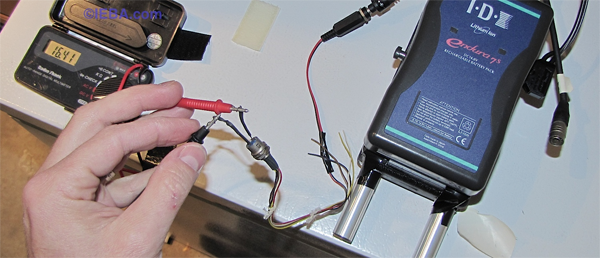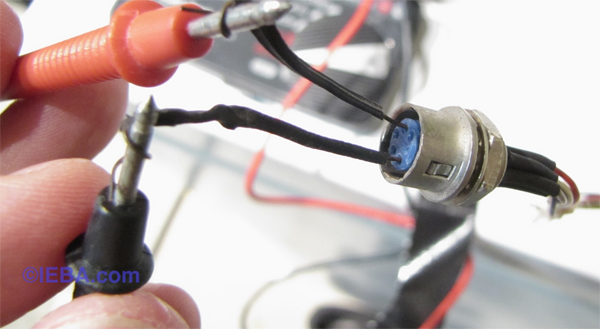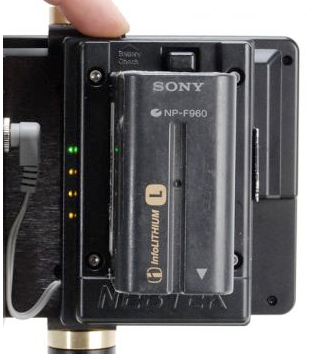Adapting ENG Lenses to DSLR Production, Part 2: Power & Rigging
Adapting servo zoom ENG lenses to your DSLR rig with suitable rails and power makes for a smooth transition from prosumer camcorder to large-sensor video camera.
But the most critical piece of information I needed was not on the page provided by Sony. I needed to know how the plug is oriented in the jack, given that it can rotate 360 degrees and the pins are symmetrical all the way around. Without knowing where the "top" of the plug is, there's no way to know for sure which pin is #6 and which is #3--the very two pins I needed to use to get power to the lens. Also, polarity is critical, because if it is applied backwards, I will blow circuits in the motor that control the zoom speeds the instant I apply power.

My 12v battery-to-lens-jack connection.
The Sony page did not show the grooves in the housing to align the "top" of the plug. This is critical. The schematic provided by my colleague Mark did show the shape of the jack. Also, take note that the schematics are provided from the wiring side--i.e., from inside the camera looking out. I connected a standard 12v jack to the wires that were indicated on the schematics. I created a D-tap to provide 12v from a V-lock battery I have. I tested each separate cable a couple times to be sure polarity was correct. I then connected them all together and tested the connection in the jack itself using some very thin wire. The pin holes are so small they make my voltage probes look gargantuan.
I had to be certain, several times over, that the voltage and polarity were correct all the way through. The instant I connected the lens cable would be a one-time shot. No do-overs. If it was wrong, the lens would be kaput.

Test, test, and test again. Be absolutely sure you got this right.
I've already been asked, "Why do you have an extra, ‘cheap' 12v connection in between the D-tap and the lens? Why not wire it direct?" I have it there for two reasons: 1, it allows me to unplug the battery and use 12v DC from a small AC adapter when I want to. 2, it's a "breakaway" point with very little resistance to prevent damage to the battery plate or the lens connector and the lens itself. The video presented in Part 1 of this series was actually using a 12v AC adapter in the house, and a battery outside the house. So it works very well both ways. Here's that video again:
When it's all put together, I have extra cable. That's not much of an issue for me as I plan on using it on my shoulder, not handheld. But this could certainly be adapted for handheld use. The trick would be finding a place to put the battery providing 12v power. For those dropping their camera into a "cage" or housing of some sort, this is not that much of an issue. But for real run-and-gun use, there is one solution I can see.

Adapting the very common Info-lithium-L batteries to 12, 7, or 5v
You can use a 7.2v camcorder battery in a housing that up-converts the voltage to a 12v regulated source. It does this by "stealing" amperage and boosting the voltage. For those of you conversant in Ohm's Law, this sort of engineering should make sense. But I'm not an electrical engineer so I'll go and buy a finished product from somebody else.
This Nebtek adapter can be made to provide 12v. I spoke to them and they can even provide me a 7.2v (native voltage from the battery) tap in addition to the 12v tap, conveniently powering both my still camera and my lens from one small and light battery.
Setting Up a Rig
Another advantage of using an ENG lens is that these lenses are designed for very brutal work. They can be used to hold and lift cameras that weigh over 10lbs. The B4 mount is very strong. My petite DSLR is only 0.86lb.
But when you attach a big lens (still or video) on the front of the still camera, trying to wield everything by holding the too-tiny grip on the GH2 is downright frustrating. Larger DSLRs will not have this issue as much, but balance with a large lens is always a concern. All the weight is in the heavy glass out in front.
Related Articles
DSLRs have become the standard by which current and future large-sensor camcorders are judged. But as we adopted DSLRs and primes to produce more "filmic" video for our clients, we left something critical behind: the feathery smooth servo zoom that serves feature film producers so well. So how do you get that capability on your DSLR?